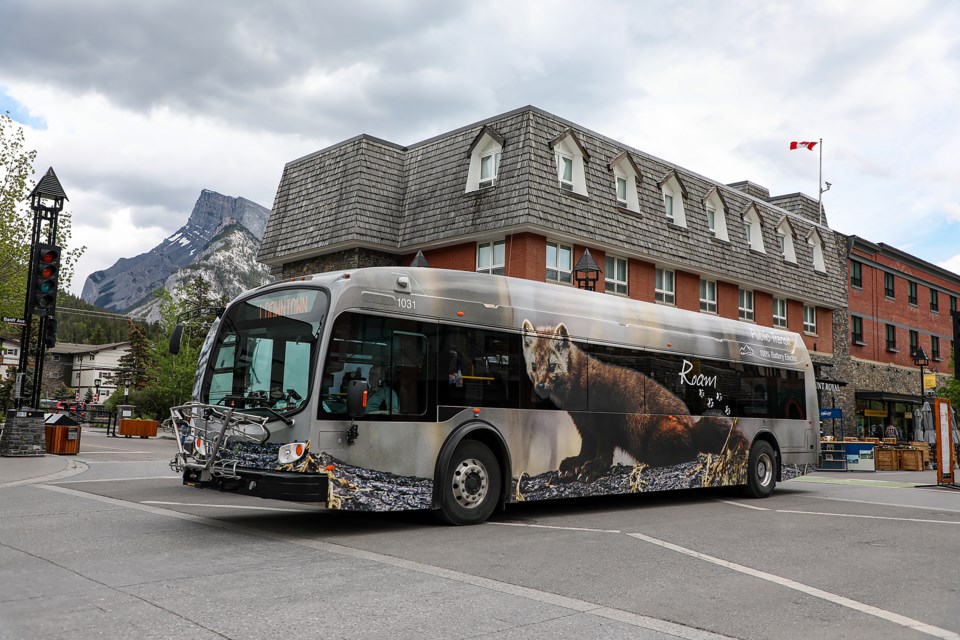BOW VALLEY – Riders using Roam’s digital app will soon have to download a newer one that will provide real-time tracking.
The Bow Valley Regional Transit Services Commission approved Roam staff moving forward with a new mobile app that allows riders to see when their bus is coming.
The decision to switch from DoubleMap is due to the app’s company having been purchased multiple times in its five years of use by Roam, leading to its eventual scheduled end in June 2024.
Martin Bean, Roam’s CEO, said having an app for customers to track bus arrival and departures is an essential aspect of providing service.
“It’s extremely important because customers come to rely on being able to look on an app or their computer to see where the buses are and plan their day around that and when to leave home to make it to the bus stop,” he said.
Bean added there’s an operational component that helps track ridership for statistics reports, helps in bus announcements and changing information for the 22 digital signs that show arrivals and departures at bus stops.
“On the operational side, our dispatchers rely on it to know where the buses are, and if they’re late on a route they may have to make adjustments because of traffic or other reasons,” Bean said.
“It does more than provide the real-time bus locations, it also controls the destination signs automatically depending on which direction you’re going and which route. ... It’s pretty integrated and necessary to let our customers know where we are and provide general information to them.”
Bean said the existing owner of DoubleMap will stop offering support for the app in June, which led Roam to put out a request for proposals. He said they received submissions and plan to review them in September.
While being approved by the commission, Bean said Roam’s RFP policy will allow the commission chair to review the decision after staff have evaluated potential options.
The commission approved the expense of $600,000, which covers $400,000 for the first year and $50,000 for each subsequent year of the five-year contract. It had previously been budgeted at $340,000, meaning $260,000 will come from capital reserves.
The staff report noted with ridership expected to surpass two million this year, a reliable app that gives riders accurate information on bus arrival is needed. Bean highlighted that as of Aug. 22, Roam ridership has reached 1.67 million passengers surpassing last year’s record high numbers.
Commission members also echoed the importance of providing real-time reliable information for riders.
“This is something customers expect and I think it helps in the backend, operationally to know where the buses are and I think it’s become such a final part of the operation,” said Corrie DiManno, a Town of Banff representative on the commission, during the Aug. 16 meeting.
Joanna McCallum, the commission’s chair and one of Canmore council’s representatives, highlighted the importance of having an app for riders.
“There’s a real expectation from the public in terms of what they’re used to in other transit systems across the world. … I definitely think that this is a public expectation,” she said.
DoubleMap was originally meant to wrap up operations this December, but it was extended for additional months. Prior to starting use with DoubleMap in 2018, the transit service used NextBus.
Bean said the apps have been popular among riders.
“We built up a really good system and a really good system of locating our buses. If we do nothing, passengers won’t know where our buses are. … I think we’re at a point where we have to do something,” he said.
Canmore stops have QR codes, with Bean estimating about 80 per cent have the QR option.
Bean told the commission it would “be a big cost saver” due to spending about $5,000 on updating signs when there’s a changeover of service to print new signs.
The transit service will also increase the number of bus stops that use QR codes rather than full schedules in the fall. The non-central route 1 and 2 stops in Banff will add a QR code that will help reduce costs and allow for quicker changes to schedules.
“At key stops we’ll keep the full schedule for people to look at a glance, but the majority of the stops will have a QR code so people can scan the code and find the schedule and also have links to the next bus arrival,” Bean said.




